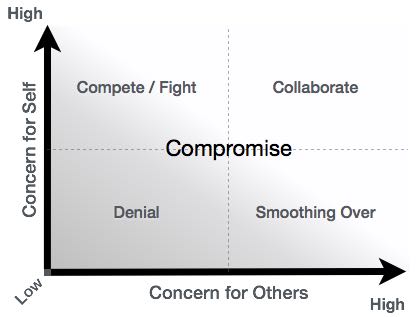
- IB Management Home
- International Trade
- General Agreements On Tariffs & Trade
- World Trade Organization
- Global Trade Major Challenges
- Modern Theories
- Global Competitiveness
- Regional Trading Blocs
- Major Trade Blocs
- Strategic Approaches
- Strategic Compulsions
- Global Portfolio Management
- Modes of Entry
- Organizational Structures
- Control Mechanisms
- Performance Issues
- Business Operations
- Production Issues
- Supply Chain Issues
- Global Marketing Mix
- Financial Aspects
- HRM Issues
- Miscellaneous
- Adverse Effects
- Conflict Management
- Negotiations
- Ethical Issues
- Useful Resources
- Quick Guide
- Useful Resources
- Discussion
Conflict Management
In this chapter, we will discuss the types of organizational conflicts and how an international business concern manages its internal conflicts.
Types of Conflicts
Conflicts in an organization can arise due to multiple reasons, based on which they can be categorized into different types.
On the basis of involvement
Conflicts may be personal (intrapersonal and interpersonal) and organizational. Organizational conflicts can be intra-organizational and inter-organizational. Inter-organizational conflicts occur between two or more organizations. Intra-organizational conflicts can be further divided into intergroup and intragroup conflict.
On the basis of scope
Conflicts may be substantive and affective. An affective conflict deals with interpersonal aspects. Substantive conflict is also called performance, task, issue, or active conflict. Procedural conflicts can include disagreements about the process of doing a job.
On the basis of results
Conflicts can be constructive or destructive, creative or restricting, and positive or negative. Constructive conflicts are also known as functional conflicts, because they support the group goals and help in improving performance. Destructive conflicts are also known as dysfunctional conflicts, they prevent people from reaching their goals. Destructive conflicts take the attention away from other important activities, and involve negative behaviour and results, such as name-calling.
On the basis of sharing by groups
Conflicts may be distributive and integrative. Distributive conflict is approached as a distribution of a fixed amount of positive outcomes or resources. In an Integrative conflict, groups see the conflict as a chance to integrate the needs and concerns of both groups. It has a greater emphasis on compromise.
On the basis of Strategy
Conflicts may be competitive and cooperative. Competitive conflict is accumulative. The original issue that began the conflict becomes irrelevant. Costs do not matter in competitive conflict. A cooperative conflict is of interest-based or integrative bargaining mode; it leads the parties involved to find a win-win solution.
On the basis of rights and interests
If some people are granted certain rights by law, contract, agreement, or established practice and when that right is denied, it leads to a conflict. These conflicts are settled by law or arbitration. In conflict of interests, a person or group may demand some privileges, no law or right being existent. Negotiation or collective bargaining solves this type of conflict.

Factors Causing Conflicts
In an international business, there can be various factors behind a conflict −
- There can be conflicts over control of resource or area.
- Conflicts can arise over the right to participate in decision-making.
- No clear-cut goals of the organization can lead to conflicts.
- No clear-cut agreements and contracts may lead to a legal mess, causing conflict.
- Misleading communication may confuse and create conflicts.
- Corruption may also create conflicts.
Conflict Management
Organizations face a great deal of conflict within and externally while doing business. Experts agree that managing conflicts can be actually quite challenging. International businesses use five distinct forms of solutions to solve conflicts. These are − avoidance, accommodation, competition, compromise, and collaboration.
The avoidance strategy tends to ignore the conflict. Therefore, it provides no resolution to the disagreement. The real source of the conflict is never addressed which leaves the situation unresolved. This ultimately drives the organization away from the work at hand and makes the conflict worse than its initial state.
The accommodation strategy believes in handling a problem as quickly as possible. In such a strategy, one party accepts the others demands. Since one party usually gets ignored, it causes an ineffective attempt at conflict management. It only shows that the dominant party continues to rule over the compliant party. This strategy leaves the analysis to conclude the reasons and necessity of a mutual resolution.
Competition occurs as both parties attempt to maximize their own agenda. Competition can quickly escalate into greed. It does not offer the parties an opportunity to benefit the organization. This strategy often becomes ineffective since the two parties are more concerned about winning than arriving at the best possible solution.
Compromise is preferably a good strategy, as both parties involved in the process are willing to give and take. They are concerned about their own ambitions, yet at the same time, they pay heed to the objectives of the organization. Each party involved in a compromise fully understands and works for the best interest of the organization.
The collaboration strategy starts with the manager taking a preliminary initiative step in handling the issue already set. Each party wants to solve the problem by cultivating a pleasing solution leading to a win-win situation. The international managers however must understand the internal environment in which the organization members function to make use of this strategy. The collaboration strategy is both assertive and cooperation; yet it smoothly takes the different points of view into consideration. Collaboration is the most effective and efficient form of conflict management.

Five As Technique
Borisoff and Victor identify five steps in the conflict management process that they called the "five A's" of conflict management − assessment, acknowledgement, attitude, action, and analysis.
Assessment − In the assessment step, the parties involved collect real information about the problem. The parties involved also choose the appropriate conflict-handling modes and decide the central factors of the problem. They also indicate compromise-able areas, and the wants of each party.
Acknowledgement − The acknowledgement step allows each party to hear out the other and both parties to build the empathy needed for the solution. Acknowledgement is more than just responding; it involves actively encouraging the other party to communicate.
Attitude − In the attitude step, parties try to remove pseudo-conflict issues. Stereotypes of different, culturally-based behaviours are unearthed. Similarly, differences in communication of men and women are accepted. Generally, we can analyze problems from the styles of writing, speaking, and other nonverbal cues.
Action − This step includes implementation of the chosen conflict-handling mode. Each individual evaluates the opposite partys behavior to ascertain potential trouble spots. Also, each individual stays aware of his own communication style and general behavior. Finally, all parties become alert to new issues and look for productive solutions.
Analysis − In this last step, participants decide on actions, and find the gist of what they have agreed upon. The analysis step initiates the impetus for approaching conflict management as an ongoing process.